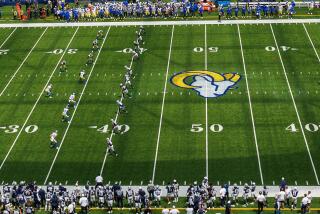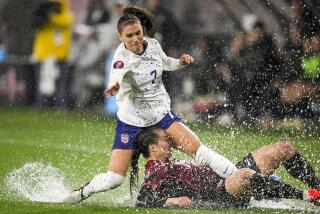WORLD CUP ’94 : The Elements of Soccer
- Share via
GAME TIME
Games consist of 45-minute halves, with the clock stopped only for injuries and the issuance of yellow and red cards. Ties can occur in first-round World Cup matches, but after that the outcome is decided first by a 30-minute overtime, then by penalty kicks.
OUT OF BOUNDS
A ball is judged to be out of bounds when it has completely crossed over an endline or a sideline.
GLOSSARY
* Chip--A lofted pass or shot on goal, usually over the head of a defender.
* Corner kick--A kick taken from either corner flag and awarded to an attacking team when the ball pases over the goal line after having been last touched by a defending team player.
* Cross--A centering pass.
* Kickoff--The game, second half and overtime periods begin with a forward touch of the ball from the center spot on the field. Opposing team players are required to be 10 yards away.
* Mark--To guard an opposing player.
* Save--Action by a goalie to prevent a shot from going into the goal.
* Tackle--To attempt to take the ball away from another player by using one’s feet.
* Throw-in--The ball is returned to play from the point it crosses a touch line by a two-handed overhead throw with both feet on the ground.
* Through ball--A forward pass that penetrates a defense.
* Volley--A kick taken before the ball touches the ground.
REFEREE
He is in sole charge of the match and has the final say in all decisions on the field of play. His primary job is to enforce the rules. He also keeps the official time.
LINESMEN
They assist the referee. They are positioned on each sideline and are primarily responsible for making offside calls and signaling when the ball is out of play.
Linesmen use flags that are raised to signal an infraction and possession on a throw-in.
SCORING
As long as the attacking team has not violated the rules, a goal is scored when the whole ball crosses the goal line--under the crossbar and between the posts.
THE BALL
Soccer is played with a leather ball about 27-28 inches in circumference and weighing 14-16 ounces.
GOAL
Posts must be eight yards apart and equidistant from the corner flags. The crossbar must be eight feet high. The circumference of the posts and crossbar may not exceed five inches.
THROW IN
The ball is returned to play from the side point it crosses a sideline by a two-handed overhead throw with both feet on the ground.
CLEATS
Different types and lengths of studs are used on the soles of the cleats depending on the field condition--whether it is hard or yielding, wet or dry, slippery or firm.
SHINGUARD
Players are required to wear a protective pad inside their socks to prevent serious injury to their shins from tackles or errant kicks.
GOALKEEPER
The goalkeeper is the only player allowed to use his hands, and then only within the goal area. He is allowed to punt or throw the ball after gaining possession, but cannot carry the ball for more than four steps.
THE FIELD
Dimensions will vary from site to site during the World Cup. Except for the fields at the Silverdome and Giants Stadium, which are 113 yards long and 72 yards wide, the soccer fields at the other sites are 115 yards long long and 74 yards wide.
*
Source: The World Encyclopedia of Soccer, Striker, Soccer Laws Illustrated, Rules of the Game, World Book
More to Read
Go beyond the scoreboard
Get the latest on L.A.'s teams in the daily Sports Report newsletter.
You may occasionally receive promotional content from the Los Angeles Times.






